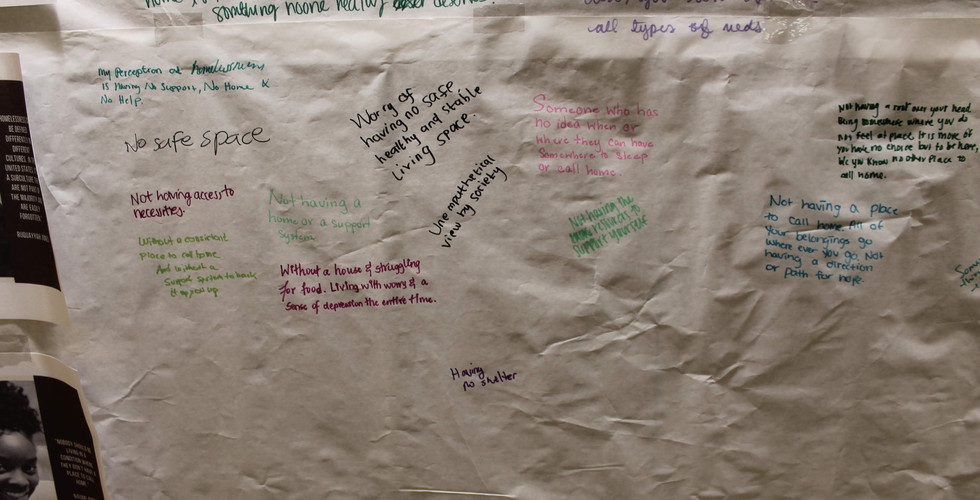Exploring College Homelessness
- Jesse Herrera
- May 21, 2020
- 7 min read
Updated: Jul 29, 2022

"No one is aware. We are having to struggle in secret. We are afraid the bias towards homelessness could keep us from graduating."
These words are from a young lady enrolled at The University of Texas in Arlington (UTA) that is experiencing homelessness. They were shared to us at our second online forum on College Homelessness, by Que Glenn, a resident at ACH Services. Over the past year we have been working with Que on this project. He has been an ear for those experiencing homelessness and a voice to express their concerns and needs. For many in our community, the thought of a college student experiencing homelessness, especially one enrolled in a four year university is not a conceivable thought.
When we think about it, what really comes to mind when we think of homelessness? Is it the individual with ruffled clothing, speaking incoherently, soliciting on the street? Is it the tent camps that get built in urban centers. Is it an individual sleeping on bare concrete during a hot summer day? These images become iconic with this experience and are often what we see portrayed in the media, movies, and our drive to work. But is this accurate? Are there aspects of homelessness we are missing? Who is really effected? And how do we better understand one's journey to homelessness?
As we have become aware of the growing need to help today's struggling college student, we also discovered how perception effects this this challenge. We shared the insights gained from Real Stories and multiple interviews conducted with fellow college students to highlight the circumstances that led them to homelessness. We learn that homelessness is perceived as more than just having a roof over your head, but having a support system. Many of the environments the students live in have some form of hostility. Some experienced domestic abuse from their significant other or a parent figure. Others witness their parent figure being domestically abuse. In the case of one student they shared how their mothers ex-boyfriend kicked them out of the house. Another shared her concern for her adopted sister living with a homeless mother, while another had to drop out of college all together.
When looking at college homelessness, we had to expand our definition. For us, homelessness was achieved once an individual lost their support system. This echoed many of the thoughts shared to us by fellow students. It is a definition that allows us to address the various ways students experience homelessness, whether it be living in a hostile environment, couch surfing, or living in a car. It allows us to focus on the social determinants that can often create the environments that lead to homelessness.
We share how perception often does not fit reality. Those effected come from a wide range of backgrounds. The students are hard working and dedicated to achieving their goal. Many are enrolled in college so they can work in professions to help others in their circumstance. They are human, and like everyone else, share in the day to day struggles. For many thought, they lack a support system which is often something we take for granted. Those with support, myself included, walk with a different stride in life, knowing someone has our back. Though we may celebrate in the idea of bootstrapping, it hardly matches the reality we experience. If we removed that support figure, whether it be from a parent, sibling, friend, or mentor, how much different would our story be?
We learn how the housing system does not have enough affordable units, and those available do not always fit the needs of a student. Housing vouchers are hit or miss. The waiting period, as shared by one of the students interviewed, can be over 7 years. Some shelters are strictly program based and have requirements that do not work well with an academic calendar. Others do not allow for children or spouses. This can be inhibiting for some, including one of the students we interviewed who was a 46 year old mother of six. The cost of living has increased consistently over the past decade. Affordable housing is in short supply, often leading to sharp price increases to units available on the market. Even with a healthy income, families are struggling to find a house that is affordable. In Texas, housing prices are increasing faster than local wages. Additionally, fall out from previous intentional tactics such as redlining, have also directly impacted certain communities from being able to acquire housing and generate wealth.
Our system is brutal, and does not offer a lot of room for mistakes. A bad divorce, as shared by one of the students, can devastate your credit and severely limit your purchasing power. In the case of this student, it resulted in homelessness for her and her children as they searched for a place to stay. We learn that help for the students has taken many forms, but a constant theme seems to finding a prominent support figure or support system. This could include a friend's father lending a hand, a mentor being an open ear, or a school counselor going out of their way to help a young lady at UTA experiencing homelessness.
"My best friend, she let me stay the summer at her house. Her dad took me in when things were extremely bad. I’m forever grateful. He’s the reason I made it to college."
I find myself revisiting some of the insights gained at a workshop on gentrification earlier this year. As the burdens our students face increase, it would seem the system we live through expects us to rise against the very failures we have created. Is this what normal looks like? Should it be normal for a college student to juggle so many priorities, to live on the edge, to worry if they can afford to pay back their loans, or to wonder if they can afford rent for the month? Should it be normal for students, or anyone for that matter to go hungry, especially when 30-40% of our waste is food? With 52% of the student base in Tarrant County experiencing housing insecurity, 61% unable to cover a $500 unexpected need, 32% experiencing food insecurity, 57% needing to prioritize supporting their family, and 72% less that confident that could repay their student debt, it would seem so.

The conversation revealed how COVID-19 has brought a new realization to how stressful things can be when we live each day with uncertainty. With our jobs in constant flux, the possibilities of ending up homeless have become a concern for some. One of the participants shared that a fellow college peer at Texas Tech in El Paso spent 2 years couch surfing because they could not afford a place to live. With 3 children this participant expressed how it is rough to be on the cusp every day, especially when unemployment is at an all time high, and hiring is frozen for many industries due to COVID-19. "What would I do to find work"? Others share in this, reflecting how the recession just 12 years prior brought similar feelings of uncertainty.For some, COVID-19 has truly been an eye opening experience, helping us to empathize with those struggling with homelessness.
As an unfair and hidden burden, college homelessness can be very difficult to detect. People do not always associate poverty or homelessness with college enrollment. Often, we see it as the first sign of success, ignoring the idea a student could be struggling outside of school. Stigma also plays a role in how comfortable students feel in sharing their struggle, leaving some to hide their experience. The day to day life at a college campus is a difficult environment to recognize disparities. There are many priorities with homework and commitments that can hinder one's observation and capacity to help. At private universities, this can be even more difficult to identify and some of these challenges are amplified.
COVID-19 has effected students directly. For many, getting access to internet has become a difficulty since libraries, coffee shops, community centers, and campuses have closed. For schools offering WI-FI hot-spots, transportation becomes a challenge for students if they do not have a bus route or reliable form of transportation they can use to pick up the equipment. As dormitories get vacated, students are unexpectedly forced to pack up and leave, with some not having a stable home to go to. Out of state students experience this and additional challenges. Some live in different time zones which can make coordinating online classes difficult. Others may be experiencing similar issues of hostility at their households. For international students, these challenges are amplified. Their visa's are usually contingent on enrollment and returning home can bring additional issues, depending on how their country is impacted by COVID-19. Other difficulties include extreme time differences, having adequate internet infrastructure, or having the ability to engage in free speech all of which can make online classes impossible. These factors leave a lot uncertainty for domestic and intentional students in completing their education. Campus services like the food pantry also become unavailable when closed, increasing the challenge local students face.
Systemic solutions can take a long time to implement. With some of the students being "one step away from a crisis", this raises the need for designing small and fast responses to address the immediate needs while efforts are made to develop more substantial solutions. This challenge is too grand to be solved by any one group or project, requiring efforts on multiple fronts. We identify a need to gather additional insights and use the stories to highlight the actualities of the homelessness. By building a better understanding of the challenge, we can then design better solutions.
Unfortunately, there is far more to this challenge than what we can cover in a hour of conversation. Though we lingered slightly over our scheduled time, there is still much to learn. This is an un-discussed and unknown topic for many. Given this, and the many insights we gained during our conversation we ask the following questions. How do we better understand what homelessness looks like? What type of follow up would help this become a more discussed topic? How do we address the stigma aspects to this challenge? How do we create environments for students that are more welcoming for them to share their experiences? And what does a true support system look like? Interesting points to build from as we explore this challenge more in depth and work to discover how to build a better future for our learners.










Comments